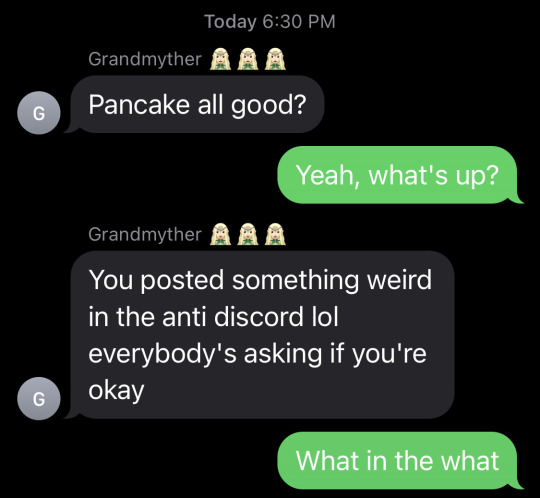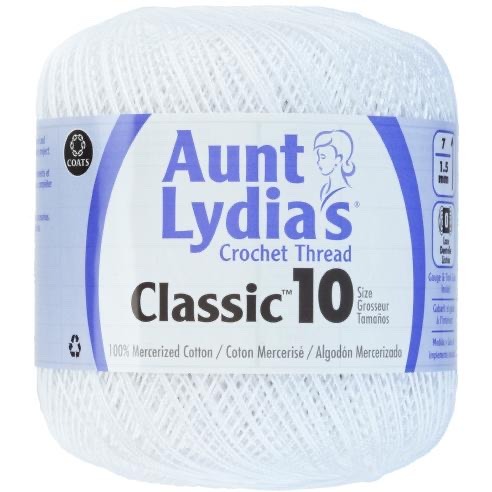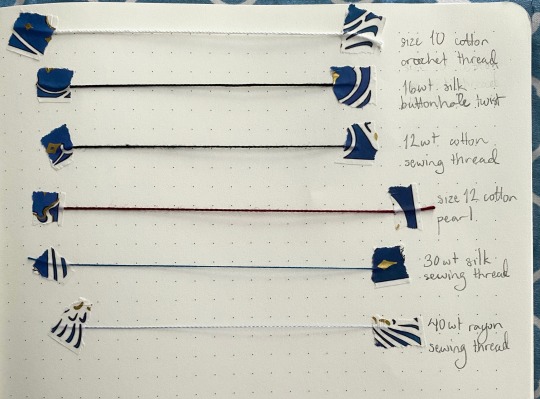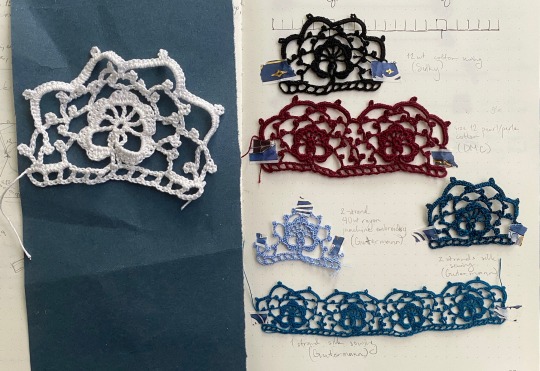#pancake talks lacemaking
Text



Damage! A broken edge and two pretty major holes that revealed themselves after being washed. The edge will be a simple repair. The holes will be more involved. I need to recreate the structure of the net and secure it to the undamaged lace without causing undue strain. Wish me luck!
#do i have cotton thread of the right weight?? not sure#pancake talks lacemaking#pancake talks textiles
24 notes
·
View notes
Text

I’ve finally reached the row where this lace begins to take shape! Trying to finish this up before I order the actual shift fabric.
#i genuinely have no idea why this is working up so much faster than the black silk version#is it just bc i can see it better???#myth and pancake make underpinnings#pancake makes the chemise a la belle#pancake talks lacemaking
23 notes
·
View notes
Text

I think there’s a special place in hell reserved just for me, on account of all the affronts to god I keep committing. This time it’s crocheting with a single strand of the fiddliest sparkle embroidery floss to make lace for a shift, historical accuracy be damned.
#although apparently i’m right on the mark for the invention of crochet#but crochet lace is a long way off#anyway i’m making a hybrid regency-edwardian shift-camisole for a georgian outfit sue me#pancake makes the chemise a la belle#myth and pancake make underpinnings#pancake talks lacemaking#pancake talks textiles
10 notes
·
View notes
Text
https://cdn.discordapp.com/attachments/860555528735031296/977783010780909568/image0.jpg


A transformation, of sorts.
I strongly recommend using the original (black and white on the left) if you’ve never done filet crochet. It’s a very easy pattern, you just have to make sure you keep track of the direction when you turn the piece, or work it in the round.
The pattern on the right is my modified version with a more open ground netting, more organic lines, and 500% more fuckery. Why, you ask? A, because I think it looks better, and B, because I would lose my fucking mind doing that many teeny tiny squares ad nauseum.
#pancake talks lacemaking#feel free to use my version but show me the results!#the original is public domain courtesy of Antique Pattern Library#an online archive of vintage and antique crochet/knitting/lacemaking etc patterns#in this house we stan the antique pattern library#also mine is even less symmetrical than the original for Reasons
11 notes
·
View notes
Text



The defeat in question:

Literally 30 boxes left of the approximately 275 needed to complete the row. FML
#the embroidery floss i used is also a little too cool toned but it’s less important lol#the antis discord still lives#pancake talks lacemaking#pancake makes the chemise a la belle#for those of you wondering what happened to the glass gown#it is still happening! i just decided to outsource my corsetmaking to a friend#so i can’t continue until he sends me my corset because that requires a much more carefully fitted bodice#the chemise a la belle is literally going to be held together by ribbons and drawstrings
7 notes
·
View notes
Text
Knitting supremacists: we can do *cables* and delicate lacy things
Irish, Russian, and Japanese crocheters:




48 notes
·
View notes
Text
Crochet Lace Beginner’s Guide - Part 1A of idk how many: Choosing a pattern
When choosing a pattern there’s a lot of things to consider, but first off, you should know what the purpose of your lace is. Is it going somewhere that is purely decorative? Or will it need to bear some strain, like if it’s used for shoulder straps? Is it something that needs to be soft and smooth and flexible because it’s touching skin? Or do we want structure because it’s a collar or cuff?
For my project I wanted soft, delicate, and flat lace to go around the top of a camisole (strappy tank top), and something sturdier to go down the center where I would attach buttons along the upper section. This is also both an under- and over-layer so I wanted something very smooth that wouldn’t make weird ridges if worn under another shirt.
My neckline lace doesn’t need to take any strain and is just there to be as pretty and comfortable as possible. It can have as many loops and floppy chains as I want, though I do prefer lace with a bit of structure. The stuff going down the middle needed to be sturdier, so fewer plain, floppy chains, more single-crochets on top of chains. I’m also using extremely fiddly thread for the lace along the top, but I will be using something stiffer down the front.
Based on the purpose, you’ll start looking at patterns. Here, I need to give a very basic overview of a few crochet stitches and their physical properties:
Chains are the most basic crochet stitch. It’s basically just a bunch of slipknots in a row. This forms a very flexible* base onto which you can add other stitches, or use on its own to create “bridges” between other stitches. *Flexibility is heavily dependent on the thread.
Single crochets (double crochets in British English) are small and very compact. They are often used to wrap around a chain as a point of connection or to cover the whole chain and effectively thicken it up and provide structure.
Double crochets (treble crochets in British English) are the primary “filling” stitch. They’re the most commonly used stitch for created solid sections in crochet. This is because they’re longer than singles, so you get more height out of them. They’re also used as connectors whenever that height is needed, like in making those rows of squares you see along the edges of many lace patterns.
Filet crochet lace is the easiest, most straightforward type of lace, because it follows a simple grid. This creates a very flat, structured, square lace that is nice if you’re making curtains but probably not what you want for like, lingerie. Also the patterns often feel a bit old-fashioned or uh Catholic:

The stuff you’re probably thinking of is more like this:

As you might have guessed there’s a huge gulf of skill between the two. Keep in mind that if you’re a total beginner, you don’t want to go for a super frilly pattern with lots and lots of loops that all have to be counted, or with complicated bits that need to be pieced together. There were many patterns I rejected because of how much effort they would require, and that would be doubly true for someone who is new to handling fine thread and tiny hooks.
These are gorgeous but I don’t have the TIME:



Like, ahahahaha—no. It would take *months* to make enough of that to actually *use* on anything. If you’re wondering why that first pic is included, despite the first two not looking too much fancier than the pattern I chose, it’s because each of those flowers must be made individually and tacked together. That’s so many thread ends that have to be hidden, so many tiny loose bits to get lost, and so on. If you have the patience for that, go ahead, but I don’t.

I settled on pattern 29 in the picture above for my neckline. There were lots of other contenders, but this one had the right balance of lots of delicate bridges and a reinforced edge, while also having a sort of scalloped effect. Lots of visual interest for the neckline, but no raised bits that would create ridges, though I could get away with having more texture because of the fineness of the silk thread. Most importantly, it’s worked in linked sections, meaning I don’t have to guess at how much I need, and there’s no unattached bits floating around.
I’m going to stop here, because to finish this topic I need to get into choosing thread, and this post is already too long.
43 notes
·
View notes
Text
Beginner’s Guide to Crochet Lace - Part 1B of who the fuck knows: Choosing Thread (so you can choose a pattern)
I’ve talked about this a lot in bits throughout my [#myth and pancake make underpinnings] posts but I’m going to get into more detail here.
When you google crochet lace, you’re going to get a lot of hits for this stuff:

It’s what crochet doilies and curtains are made out of, and it’s your basic, easily worked, traditional thread. Excellent choice for practice because it’ll get you used to using thin thread and a tiny hook.
But there are so many more (better) options that will better suit your needs. What exactly are your options?
Lace-weight yarn - exactly what it says on the tin. It’s a very fine yarn that is typically used for knitted lace. Can be very affordable or extremely expensive, depending on the fiber-content. Also known as cobweb or superfine. The sizing for lace-weight yarn is the most complicated and least consistent across brands, because a yarn that is 50 wraps per inch and one that is only 30 wraps (much thicker) will both be consider lace-weight. You’ll have lots of color and texture options, however.
Crochet thread (or crochet cotton, as I often call it, but there are some linen ones, I believe) - that’s the Aunt Lydia’s stuff. Comes in a range of sizes, but smaller weights are hard to find and only come in boring colors for the most part. Very consistent sizing, small numbers being the thickest, big numbers being thinner. 20-30 are the thinnest sizes you’ll be able to find easily, and probably only in white and off-whites (ecru or cream).
Pearl cotton - this is a type of embroidery thread that is very shiny and sturdy like a crochet thread but has a more noticeable twisted texture. Not really an issue at the size you’ll be using, and comes in a wide range of colors, because it’s usually used for embroidery. Also follows an inverse sizing scale, like crochet cotton, but it’s a different scale. Not many brands, but DMC has a pretty decent range of colors and is carried by Jo-Ann.
Embroidery floss - FRAGILE. It is loosely twisted to give it “spread” when doing embroidery, but this means it lacks density and strength. A hard pull will break the thread and it is prone to fraying. It only comes in short lengths, too. The one major advantage is the enormous range of colors and the affordability of cotton floss. No sizing scale, floss is floss. You can customize by increasing/decreasing the number of strands you use. If you insist on floss, I recommend a minimum of two strands.
Silk buttonhole twist or topstitching thread - comes on cards or spools, literally impossible to find in higher yardages, and expensive as all hell. As thick as thinner crochet cottons. You physically can make lace out of this and it would probably be very nice, but you literally just can’t buy enough of the stuff to make anything substantial.
Machine embroidery thread - I will talk about silk sewing thread later, here I want to focus on “art silk,” which is a fancy marketing name for artificial silk. This is going to be either polyester or rayon. I’ll talk more about the properties of various fibers later. Very shiny, inexpensive, comes in a few different weights (I haven’t tried these yet because I can’t get thicker weights locally). Sizing is also inverse but AGAIN VERY DIFFERENT from both crochet cotton and pearl cotton.
Machine sewing thread - polyester, cotton, and silk (also nylon but you’re probably not going to make lace out of nylon). Many sizes, from stupidly small and not usable for crochet, to as thick as the thinner crochet cottons. Uses the same sizing system as machine embroidery thread, but the actual thickness depends on fiber content. A 30wt cotton and 30wt silk are not the same. You can double up thread for thickness and sturdiness.
Turkish lace thread - almost always polyester, comes in very bright colors, super shiny. I have no idea where to reliably buy it and I’m morally opposed to using plastic whenever avoidable, but I’d be remiss not to mention it, because the stuff is literally designed for lace crochet.
OKAY. SO. Time to talk about FIBER CONTENT.
You got a lot of options if you use yarn, but honestly most of those options are not tiny-crochet friendly. Anything with wool in it, while soft and pretty, is going to be a BASTARD. Wool likes to catch onto itself, and unlike cotton does not come mercerized to prevent little fuzzies. Do not use wool for crochet lace unless you enjoy crying. Just don’t. Like, I’m using the most fiddly, tiny, bastard thread and I’m telling you wool is a terrible idea.
So what does that leave?
Rayon/viscose/“bamboo cotton” - not cotton at all! It’s reconsituted cellulose, which is fancy speak for plant stuff getting broken down into sludge using chemicals and then formed back into clean cellulose filament using more chemicals. It’s beautiful, can be matte or shiny as hell, and is often used for “art silk” aka artificial silk (the other most common fiber for art silk is polyester. blech). This is what @longsightmyth refers to as “slippery beautiful bastard rayon thread.” In machine embroidery thread, it is tightly twisted and less prone to catching on your hook, but is so fucking slippery. As yarn...good luck.
Cotton - actual cotton. We’re all familiar with this. It’s a sturdy, strong fiber, and easily the most beginner-friendly. It stays on your hook and is less likely to shift around or twist up weirdly while you work with it. Easy to find, cheap, lots of options. Also, you’ll notice a lot of threads say they’re “mercerized.” Mercerization is a process by which stray fuzzies are burnt off of the thread to leave it super smooth and shiny. I recommend size 20-30 crochet cotton for lace with some stiffness to it, or a 12wt sewing thread for something more flexible. You can go down as small as 30-40wt for extra-fine lace. Size 12 pearl cotton is also gorgeous and creates a compact lace with lots of structure.
Silk - the most expensive option, but worth the cost for a few reasons. This shit is strong. It’s smooth and shiny and is the least prone to fraying of all the fibers I’ve listed. Silk is... also weird. It’s not stretchy, per se, but silk sewing thread has a slight elasticity to it that cotton does not, making it incredibly fiddly as a single strand. The same smoothness that makes it beautiful makes it prone to slipping, but makes it a dream to work with doubled up. It also makes it much softer against the skin than cotton, but sturdy when using a heavier weight. Silk yarn is heavy and drapey and comes in many, many colors but will also gut your wallet. Silk machine embroidery thread is probably similar to sewing thread in terms of how it behaves but is shinier, and therefore slippery-er.
Polyester - fuck polyester.
BUT WHAT ABOUT SIZING?
Look. There’s a lot of sizing guides out there that explain what exactly each type of thread uses. They’re not helpful if you want to know how the different systems compare, and especially not if you’re trying to figure out if a non-crochet thread will look nice crocheted.
So here is a sizing guide of various common, easy to acquire threads relative to each other and how they look worked into a pattern.
From thickest to thinnest:
Size 10 crochet cotton
16wt silk buttonhole twist (not patterned bc I don’t have enough for a motif)
12wt cotton topstitching thread
Size 12 pearl cotton
30wt silk sewing thread, 2-strand
30wt silk sewing thread, 1 strand
30wt rayon machine embroidery thread


Notice what a massive fucking difference the size of the thread makes! Size 10 crochet thread is orders of magnitude larger than any of the other options! Two strands of rayon works up to approxiamately the same size as 2 strands of silk, but it’s stiffer.
Choose your threads according to the pattern and purpose, and vice versa! I’m doing a tiny lace edging on a delicate undergarment, so I want a super delicate lace to go with my super delicate cotton. If you’re trimming a jacket collar or dress bodice a size 12 pearl cotton or doubled silk would make more sense.
#this had been sitting in my drafts FOREVER but here it is#pancake talks lacemaking#pancake talks textiles
31 notes
·
View notes
Text

All those squares took around 3-4 hours to complete. But it’s finally acquiring some structure!! Which is a huge relief because it’s soooo fiddly right now.
6 notes
·
View notes
Text

Completely scrapped the first attempt. It’s turning out much nicer this time even though it doesn’t look like it lol. I went up two hook sizes which really helped with keeping my stitches loose (although it’s hard to control the sizing). There’s still some places where i would definitely change things on the final version but not bad enough to warrant starting over or going back lmao
12 notes
·
View notes
Text

Three rows of baby pink silk vs twelve rows of burgundy cotton. Holy shit the silk is so soft. I cannot shut up about how soft it is. This tiny piece feels like a cloud in my hand and it works up so quickly and it’s SO SHINY i made a terrible financial decision and ordered some for myself. IN MY DEFENSE the color was named Justice and it was a really beautiful mix of purpley blues?? And my hopeless little magpie brain just went “INEJ!!!!”
#it’s fine i can afford it i just shouldn’t have bc ive spent a lot of money on yarn now#i also have several skeins of a wool-silk blend that isn’t nearly as lovely#that i will have to do *something* with#perhaps i shall make things for Selling#pancake talks lacemaking
8 notes
·
View notes
Text

We’re in the testing phase! I got impatient waiting for my yarn to arrive, so I’m starting off with some cotton. I figured it was probably best to practice with something cheap first and not the $15-a-skein silk. Who knows, maybe if it turns out nice, I’ll keep it.
#i’m probably going to frog several rows though because I realized belatedly it would work better if I switched out some of the stitches#pancake talks lacemaking
5 notes
·
View notes
Text

Altering a crochet pattern to suit my taste. Diagrams are usually drawn out as all the individual stitches to show the points of connection and the number/type, but in the drafting phase it’s easier for me to block out shapes and spaces than deal with the details.
This is part of a larger design for a shawl I’m making as a gift for my brother’s gf. It also happens to be the pattern i’m using on my socks, so if it turns out nice i’ll use it on those as well.
5 notes
·
View notes
Text

Added approximately a bajillion more oak leaves to the pattern and streamlined the netting. Also added a little border to the edge which is a crochet approximation of a knit motif called double waterlily:

The pointy bits are just me making shit up based on how a lot of shawls terminate in pointy bits like this:


Right now my stitch counts are mostly guesswork, but the *geometry* of the pattern is solid. I just won’t know exactly how many chains I’ll need to bridge the gaps until I actually test the pattern. Also I was planning for every leaf to have two beads but I don’t think I ordered enough beads for that lmao.
4 notes
·
View notes
Text

It’s been awhile since I posted an update on the Actual Lace! But here’s what I have so far: 15 little flower centers all linked up and waiting (this pic was taken before I stopped last night). I need about 20 more before I have enough length for my neckline, but we’re GETTING THERE. It’s a lot of work but it progresses pretty quickly when you get into the swing of it. We’ll see how many spools of this silk I end up consuming. If I have enough leftover I’m going to make some little wedge-shaped inserts for a pair of drawers.
5 notes
·
View notes
Text


I switched hook sizes for the sake of looser lace 😔
1 note
·
View note